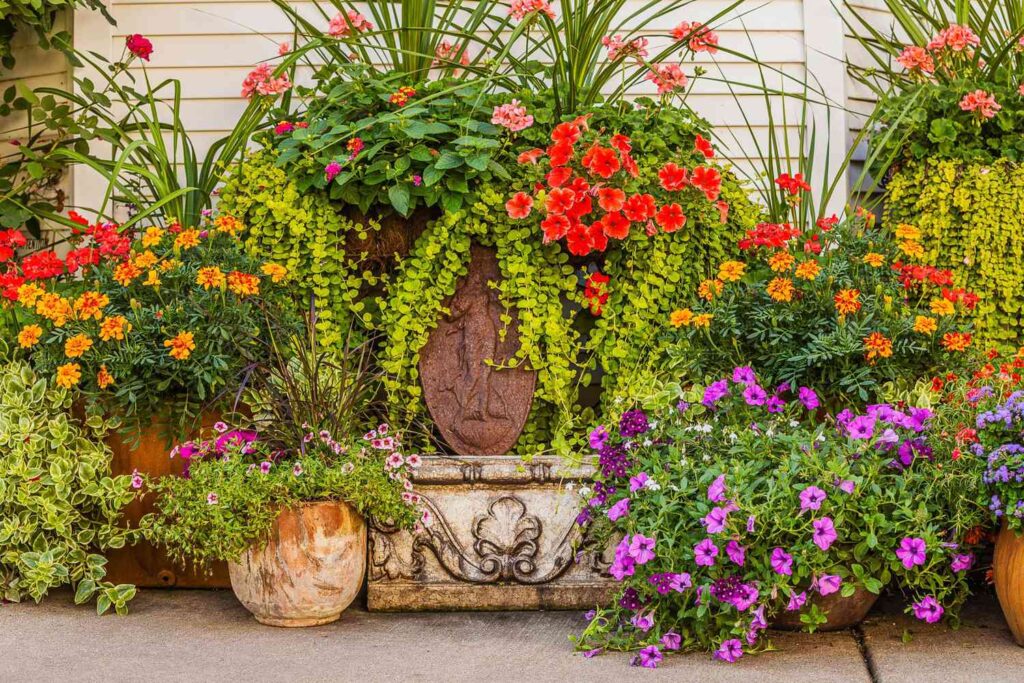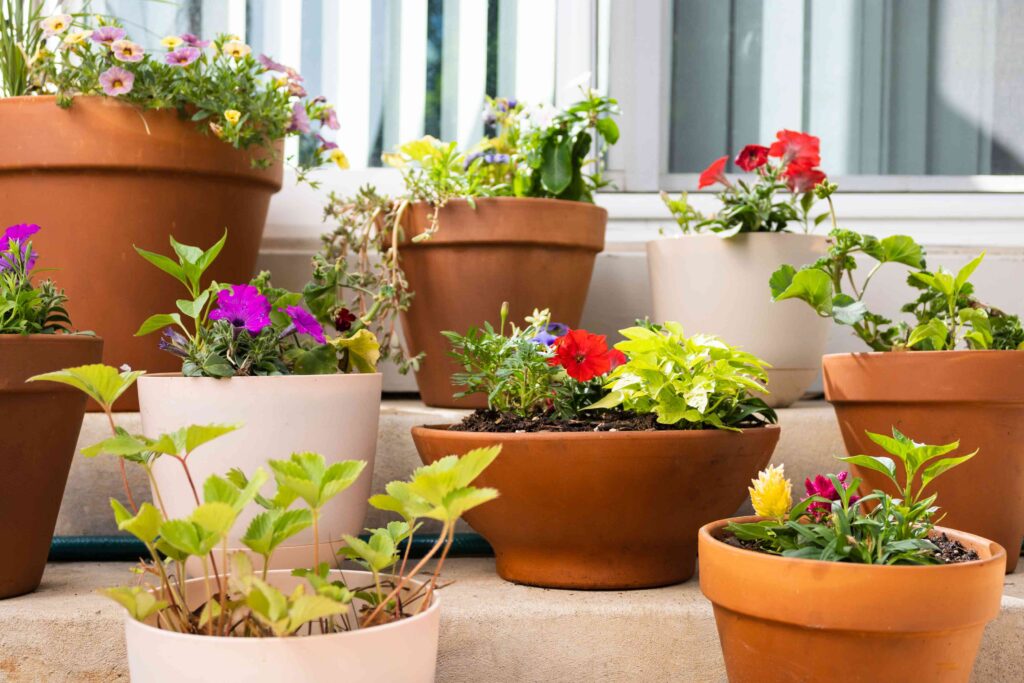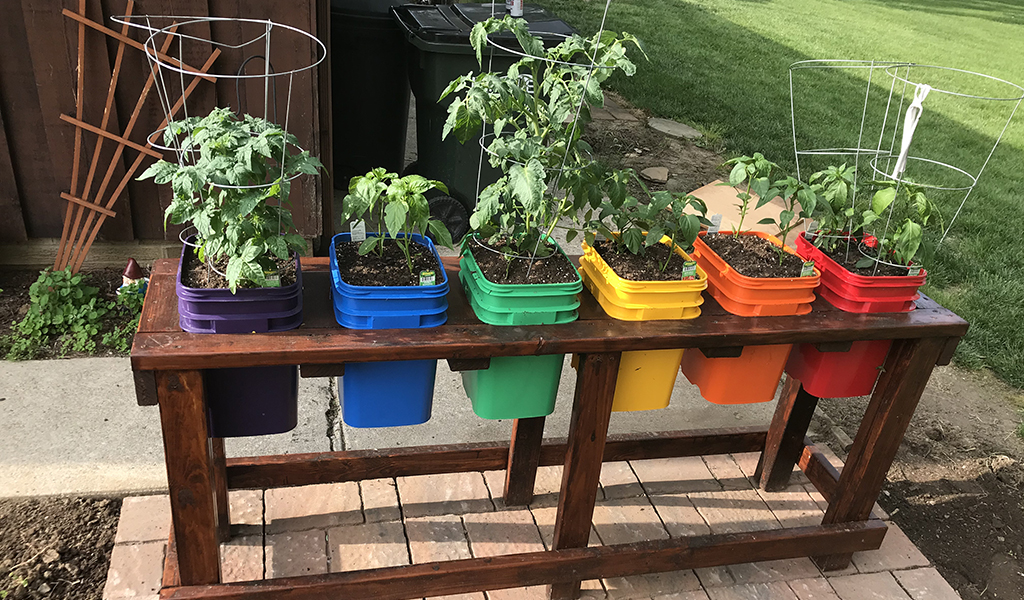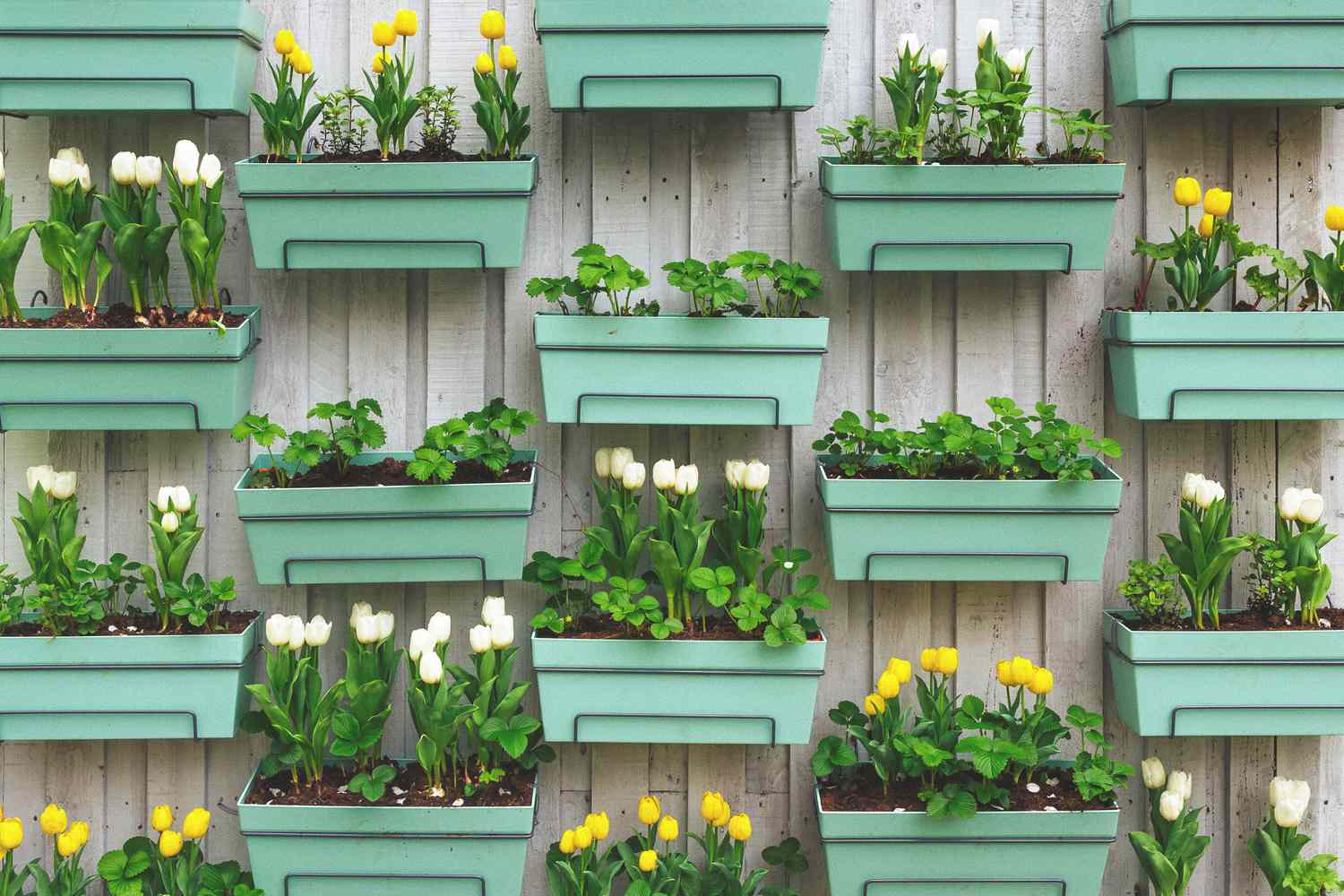Container gardening is a versatile and accessible way to bring the joys of gardening to any space, regardless of size or location. Whether you have a spacious backyard, a small balcony, or even just a windowsill, container gardening allows you to nurture plants, flowers, herbs, and even vegetables in portable and manageable containers.
You can still enjoy container gardening even if you don’t have access to a yard. You may discover that, after you get the hang of container gardening, you’re growing more and more pots every year. However, the care procedures needed to maintain plants alive and well in containers differ from those needed to cultivate plants in the ground.
They provide visual appeal, there are many different pots and planters available to plant in, and you are not limited in where you may put the plants. You can produce veggies and plants in planters anywhere at any time with container gardening.
You can cultivate your own food even in a tiny area. Whether you have access to a rooftop, balcony, or step, a container garden can be ideal for you. In this comprehensive guide, we’ll explore the benefits, essential elements, plant selection, and practical tips for successful container gardening.

Interested in gardening, learn about Straw Bale gardening.
Benefits of Container Gardening
Container gardening is a versatile and accessible approach to cultivating plants, flowers, herbs, and vegetables in portable containers. Whether you have a sprawling backyard or a small balcony, container gardening brings the joy of gardening to any space. Explore the diverse benefits that make container gardening an attractive and practical choice for individuals of all gardening levels.
Space Efficiency
One of the primary benefits of container gardening is its space efficiency. This gardening method is ideal for those with limited outdoor space or no traditional garden beds. Whether you live in an apartment, have a small patio, or just a window ledge, containers provide the opportunity to create a mini garden, transforming any space into a green oasis.
Mobility and Flexibility
Containers offer the advantage of mobility, allowing you to move your plants around as needed. This is particularly beneficial for individuals in apartments or those with changing outdoor environments. If certain plants require more sunlight or protection from harsh weather conditions, containers provide the flexibility to cater to these needs.
Soil Control
Container gardening allows for complete control over the soil composition. This is especially advantageous if the native soil in your area is not ideal for the plants you want to grow. Gardeners can customize the soil mix in each container, ensuring it meets the specific needs of the chosen plants. The ability to tailor the soil promotes healthier plant growth and development.
Aesthetic Appeal
Containers add aesthetic appeal to outdoor spaces. Gardeners can choose containers that complement the overall design theme, creating visual interest and enhancing the beauty of their surroundings. From terra cotta pots to decorative metal containers, the variety of choices allows for creative and visually pleasing container arrangements.
Accessibility
Container gardening is accessible to individuals of all ages and physical abilities. For those with physical limitations or individuals who find traditional gardening challenging, container gardening offers a more manageable alternative. The raised height of containers reduces the need for bending or kneeling, making gardening tasks more accessible and enjoyable.
Essential Elements of Container Gardening
Container gardening offers a unique and versatile way to cultivate a thriving garden in limited spaces. To ensure success in this method of gardening, understanding and implementing essential elements is crucial. From the choice of containers to the type of soil and the regular care provided, each element plays a vital role in creating a healthy and vibrant container garden.

Containers
Selecting the appropriate containers is the first and fundamental step in container gardening. Containers come in various shapes, sizes, and materials, each influencing the growing conditions for plants. Consider the following factors:
- Size – Choose containers that match the growth habits of your plants. Larger plants or those with extensive root systems require more spacious containers to thrive.
- Material – Different materials, such as terra cotta, plastic, wood, or metal, have varying impacts on soil temperature and moisture retention. Select materials based on your climate and the needs of your plants.
- Drainage – Ensure that containers have drainage holes to prevent waterlogging, which can lead to root rot. Adequate drainage is crucial for the health of plants.
Soil Mix
The soil mix is a critical component of container gardening success. Unlike traditional garden beds, where plants can draw nutrients from the surrounding soil, container plants rely solely on the soil within the container. Create a well-draining and nutrient-rich soil mix by considering the following:
- Potting Mix – Start with a high-quality potting mix designed for container gardening. Potting mixes are formulated to provide proper aeration and drainage.
- Perlite – Add perlite to the mix to improve drainage and prevent soil compaction. Perlite also helps maintain an open structure in the soil, promoting root health.
- Compost – Incorporate compost to enrich the soil with organic matter and essential nutrients. Compost enhances soil fertility and encourages beneficial microbial activity.
Sunlight
Understanding the sunlight requirements of your plants is crucial for their overall health and productivity. Different plants have varying preferences for sunlight, and placing containers in the right location is essential. Consider the following:
- Full Sun – Some plants, like tomatoes and peppers, thrive in full sun and require at least six hours of direct sunlight per day. Place containers with these plants in areas with ample sunlight.
- Partial Shade – Shade-loving plants, such as ferns or certain varieties of begonias, can flourish in areas with filtered or indirect sunlight. Consider the sunlight preferences of your chosen plants when arranging your containers.
Watering
Container plants have unique watering needs compared to traditional garden beds. Containers can dry out quickly, and regular, consistent watering is crucial. Implement the following practices to ensure proper hydration:
- Monitor Soil Moisture – Regularly check the moisture level of the soil by inserting your finger into the top inch. Water when it feels dry to the touch, but avoid overwatering to prevent root rot.
- Use a Saucer – Place containers on saucers to catch excess water. This prevents water stains on surfaces and allows plants to absorb any water that drains out, minimizing waste.
Fertilizing
Container plants rely on the gardener for their nutrient supply, as nutrients are washed out more quickly in the confined space of a container. Fertilizing is essential to ensure robust growth and continuous flowering. Consider the following:
- Balanced Fertilizer – Choose a balanced, water-soluble fertilizer with equal proportions of nitrogen, phosphorus, and potassium (N-P-K). This provides a well-rounded nutrient supply for plants.
- Application Rates – Follow the recommended application rates on the fertilizer package. Over-fertilizing can lead to nutrient imbalances and negatively impact plant health.
Plant Selection for Container Gardening
Selecting the right plants is a crucial aspect of container gardening success. The confined space of a container requires thoughtful consideration of the size, growth habits, and sunlight preferences of the chosen plants. Explore the following categories of plants that are well-suited for container gardening:
Herbs
Herbs are excellent candidates for container gardening, offering fresh flavors for culinary use and delightful fragrances. Consider the following popular herbs for containers:
- Basil – An essential herb in many cuisines, basil thrives in containers. Choose compact varieties for smaller spaces.
- Rosemary – This aromatic herb is well-suited for containers and provides a steady supply of flavorful leaves.
- Mint – Mint varieties, such as peppermint or spearmint, can be grown in containers to prevent their invasive spreading.
Flowering Plants
Flowering plants add vibrancy and visual appeal to container gardens. Choose from a variety of annuals and perennials with different bloom times:
- Marigolds – Compact and colorful, marigolds add a burst of gold and orange to container arrangements.
- Petunias – These versatile annuals come in various colors and are well-suited for hanging baskets or containers.
- Geraniums – Known for their bright blooms, geraniums thrive in containers and can withstand heat and drought.
Container Gardening Vegetables
Many vegetables are well-suited for container gardening, making it possible to grow fresh produce in limited spaces. Consider the following vegetables for container cultivation:
- Tomatoes – Compact or dwarf varieties of tomatoes, such as cherry tomatoes, are excellent choices for containers.
- Peppers – Bell peppers or chili peppers can be grown in containers, providing a bountiful harvest in a small space.
- Lettuce – Leafy greens like lettuce or spinach can be grown in containers for fresh salads.
Fruits
Certain fruit varieties are suitable for container gardening, allowing you to enjoy homegrown fruits even in small spaces. Consider the following fruit options:
- Strawberries – Compact and prolific, strawberries are well-suited for hanging baskets or containers.
- Dwarf Citrus Trees – Varieties like dwarf lemon or lime trees can be grown in containers, providing a citrus harvest.
Foliage Plants
Foliage plants add texture and greenery to container arrangements, creating a lush backdrop for other plants. Consider the following foliage plants for container gardening:
- Ferns – Shade-loving ferns add a touch of elegance and lushness to container gardens.
- Coleus: Known for its vibrant foliage, coleus comes in various colors and patterns, adding visual interest.
- Ornamental Grasses – These plants provide graceful movement and texture, especially in larger containers.
Practical Tips for Successful Container Gardening for Beginners
Container gardening offers a dynamic and versatile way to cultivate a thriving garden in confined spaces. To ensure success and maximize the potential of your container garden, consider implementing these practical tips that address key aspects of care, maintenance, and optimization.
Choose Appropriate Container Sizes
Selecting the right container size is crucial for the health and development of your plants. Consider the mature size of the plants you intend to grow and choose containers that provide ample space for root expansion. Larger plants or those with extensive root systems require larger containers to thrive. Conversely, smaller containers are suitable for compact or dwarf varieties.
Ensure Adequate Drainage
Proper drainage is essential for preventing waterlogged soil, which can lead to root rot and other issues. Ensure that your containers have drainage holes at the bottom to allow excess water to escape. Elevate containers slightly by placing them on pot feet or small bricks to further enhance drainage. This simple step contributes to the overall health of your plants.
Rotate Containers for Sun Exposure
Plants tend to grow in the sunlight, and regular rotation of your containers ensures that all sides of the plants receive equal exposure. Rotate containers every week or two to promote balanced growth and prevent one side of the plant from becoming overly stretched. This practice is especially important for plants placed in areas with uneven sunlight.
Monitor Watering Needs
Container plants may require more frequent watering than those in traditional garden beds. The key is to find the right balance. Regularly monitor the moisture level of the soil by inserting your finger into the top inch. Water when the soil feels dry to the touch, but avoid overwatering, as this can lead to root rot. Adjust your watering schedule based on the specific needs of your plants and the prevailing weather conditions.
Mulch to Conserve Moisture
Applying a layer of mulch on the soil surface helps retain moisture, regulate soil temperature, and suppress weed growth. Organic mulches, such as straw, bark, or compost, are effective in conserving moisture and creating a protective barrier for the soil. Apply a 1-2 inch layer of mulch, leaving a gap around the base of the plant to prevent moisture-related issues.
Regularly Inspect for Pests
Container plants are not immune to pests, and early detection is crucial for preventing infestations. Regularly inspect your plants for signs of pests such as aphids, spider mites, or caterpillars. Check both the upper and lower surfaces of leaves and stems. If pests are detected, use organic or chemical controls as needed, ensuring that the chosen method is suitable for the specific pest and plant.
Prune and Deadhead
To promote continuous blooming and maintain a neat appearance, regularly prune and deadhead your container plants. Remove spent flowers and trim back leggy growth. Pruning encourages bushier growth and redirects the plant’s energy toward producing new flowers. Deadheading prevents the plant from directing energy into seed production, encouraging it to focus on blooming.
Protect from Extreme Weather
Containers are more susceptible to temperature fluctuations than plants in the ground. During extreme weather conditions, such as frost or heatwaves, consider moving your containers to a more sheltered location. In colder climates, insulate containers with bubble wrap or hessian to protect plants from freezing temperatures. In hot climates, provide shade during the hottest part of the day to prevent heat stress.
Choose the Right Plants for Your Climate
Selecting plants that are well-suited for your climate is essential for successful container gardening. Consider the local temperature range, sunlight availability, and rainfall patterns. Choose plants that thrive in your specific conditions to minimize stress and enhance overall resilience.

Container Gardening FAQs
Which material is suitable for container gardening?
Terracotta or Wood is considered best for container gardening.
How often should I water my container plants?
Container plants may require more frequent watering, especially during hot and dry periods. Water when the top inch of soil feels dry, but be cautious not to overwater to prevent root rot.
What practical tips can enhance success in container gardening?
Practical tips include choosing appropriate container sizes, ensuring adequate drainage, rotating containers for sun exposure, monitoring watering needs, regularly inspecting for pests, pruning and deadheading plants, mulching to conserve moisture, and protecting plants from extreme weather conditions.
What is the best plant for a container?
These include blooming plants such as Skimmia japonica and hebes, and hardy evergreen foliage plants such as yucca, English ivy variegated euonymus and heuchera. Because they are constantly in leaf and hence have something to offer the display, evergreens are usually the ideal choice for year-round pot displays.
Conclusion
Container gardening opens up a world of possibilities for cultivating greenery and blooms in spaces of all sizes. Whether you have a sprawling backyard or a modest balcony, container gardening allows you to tailor your garden to your specific environment and preferences.
By understanding the essential elements, selecting the right plants, and following practical tips, you can create a thriving container garden that brings nature’s beauty to your doorstep. So, grab your containers, choose your favorite plants, and embark on the journey of cultivating a green oasis wherever you desire.


